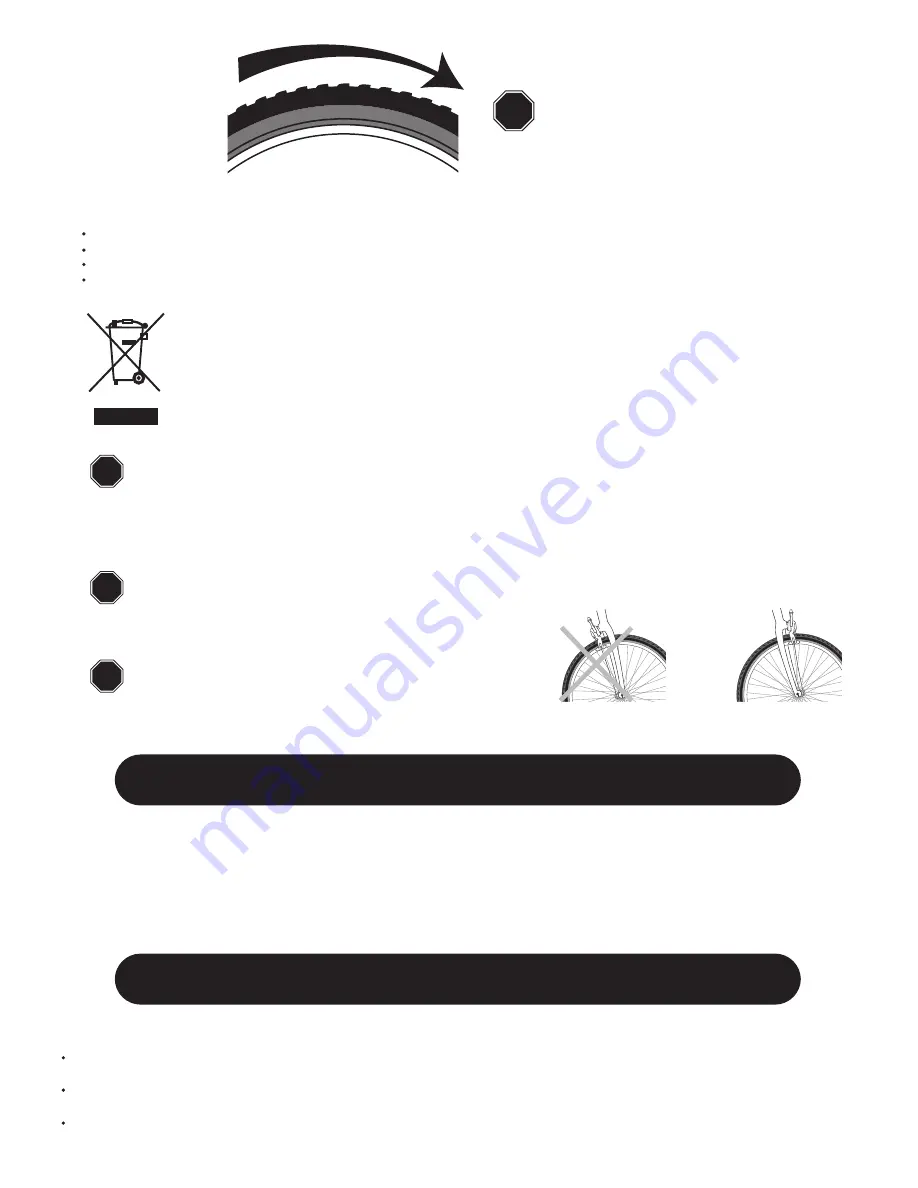
- 10 -
The lighting system is part of your bicycle’s safety system and must be fitted to your bicycle. Check that your
lighting systems are working and that the batteries are sufficiently charged before setting off. Used batteries
contain metals which are harmful for the environment (Hg: mercury, Cd: cadmium and Pb: lead): they can be
taken to our shops to be disposed of appropriately; do not throw them away with household waste. Batteries
should be collected separately.
The “crossed-out bin” symbol means that this product and the batteries it contains must not be thrown away
with general household waste. They are subject to a specific type of sorting. Please take the batteries and your
unusable electronic product to an authorised collection point for recycling. This treatment of your electronic
waste will protect the environment and your health.
Note that 14.5 PSI = 1 BAR and 1 BAR = 1kg/cm = 100,000 Pa
Fitting the wheels: Read the section on using quick connectors.
How front and back brakes work: Refer to the chapter on the braking system entitled “checking the brakes”.
Fitting the pedals: Refer to the chapter entitled “mounting the pedals”.
How the lights work:
Before each outing, you should check
that there is no movement between the
different parts of the assembly!
Warning about automatic pedals:
Automatic pedals are tricky to use and require a period of familiarisation to avoid falling off:
Engage and disengage your shoes in the pedals before setting off. The interface between the cleat and the pedal can be
affected by a number of factors including dust, mud, lubrication, spring tension and general wear.
When engaging and disengaging, check how the mechanism works and familiarise yourself with how the pedals feel.
Warning about the frame and fork suspensions:
Refer to the instructions supplied with this manual. Before every ride you must check that there is no movement between
any of the different parts of the assembly. If there is, only consult qualified
personnel and/or your nearest shop, in order that they
can carry out the necessary adjustments.
Warning about fork direction (position, brake, etc…):
m
Some parts of your bicycle will require slight modification after 2 to 3 hours’ use, mainly in order to make final adjustments to the
components. Derailleur cable tension is to be set: the housings will settle down, necessitating new derailleur and brake tensions.
(See chapter on adjusting derailleur tension). With single-speed bikes, pedalling may seem difficult at first. This is completely normal,
and after a few hours’ use pedalling will become easier: the chain loosens naturally. After your first use of a bike with a 6-piece
bottom bracket, you will need to tighten up the bottom bracket. To do this, please consult a qualified person and/or our technical
workshops.
Rotation direction
Your bicycle needs a minimum amount of maintenance and regular services. How often it needs to be serviced depends on bicycle type (city,
racing, mountain), how often you use it, and how you use it. Your bicycle’s maintenance depends on how you use it:
City and recreational bikes, racers and BMXs require regular maintenance: Oil the chain regularly, brush the cogs and chain rings, periodically
place a few drops of oil in the brake and derailleur cable housings and remove dust from the brake pads.
MTBs should be cleaned after riding on muddy or dusty terrain: frame, wheels, chain, chain rings and cogs; then lubricate the chain using the oil
specifically designed for bike drive trains. Should you detect any deterioration in parts of your bicycle, please replace the parts concerned.
Check the tires for excess wear, cuts or bruises. Replace them if necessary.
Check the wheel rims for excess wear, dings, dents and scratches. Consult your dealer if you see any rim damage.
TAKING GOOD CARE OF YOUR BICYCLE
ADJUSTMENTS AFTER SEVERAL HOURS’ USE
STOP
STOP
STOP
STOP
Summary of Contents for Bicycle
Page 1: ...User guide and terms of guarantee...
Page 23: ...23 2 2 3 h Hs Hg 2 3...











































